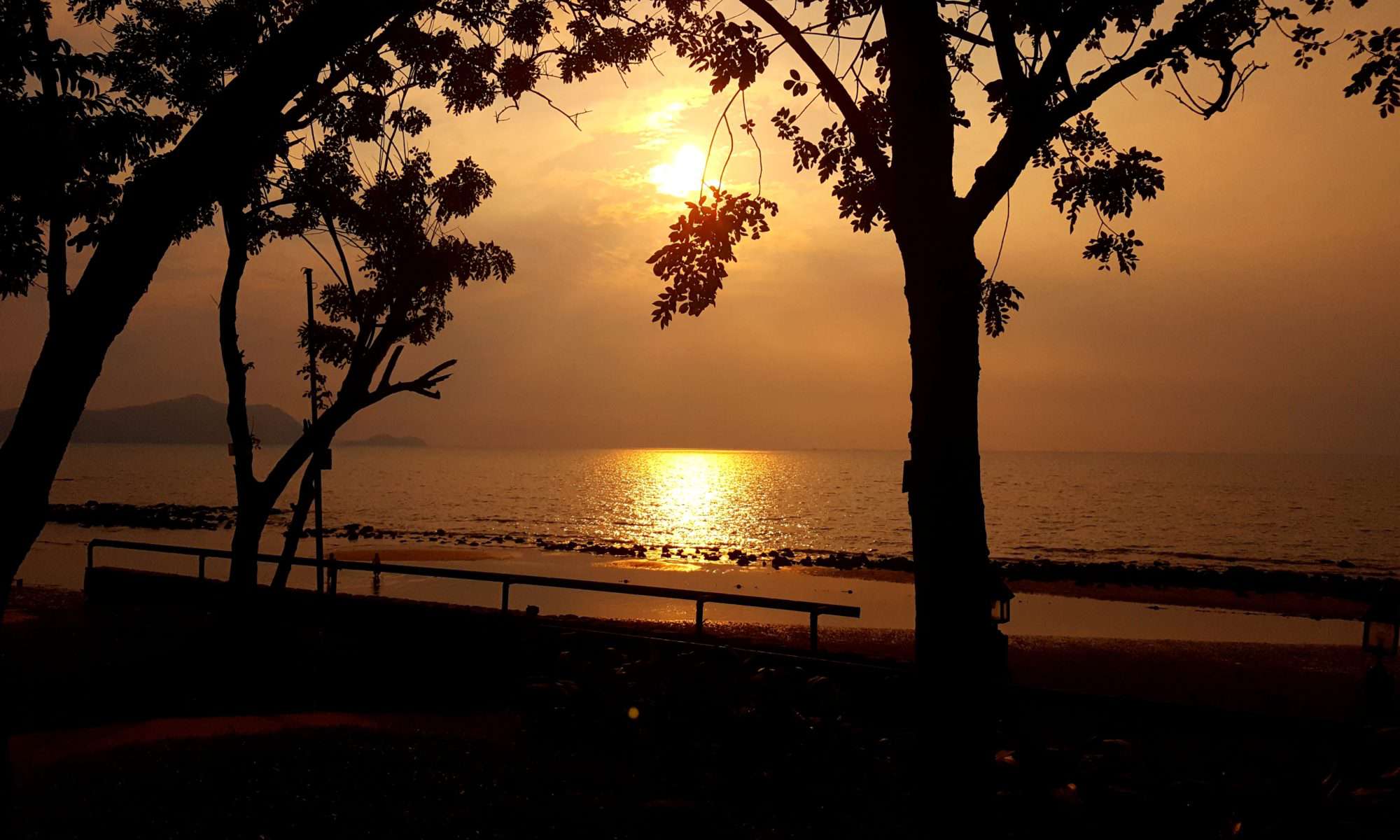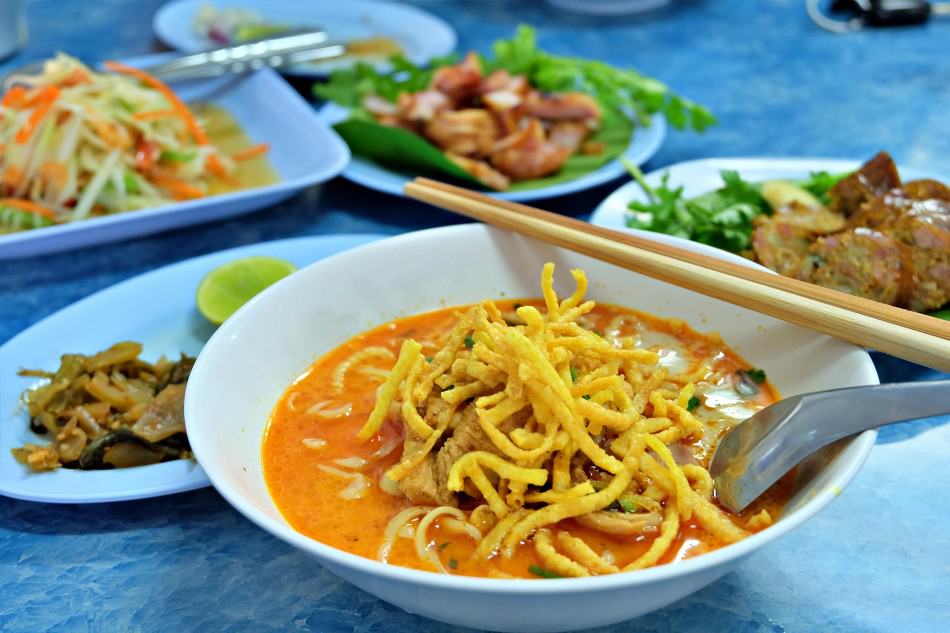
Eat, eat, then eat again — that’s what you should do in Chiang Mai, a food paradise, according to my friend Fiat Natanan. He was born into a Chiang Mai family and has a strong connection with Chiang Mai and northern Thai food (also known as Lanna food).
He has told me about his childhood excitement during holidays like New Year’s Day and Songkran Day (Thai new year’s in April) when his parents would take him to their hometown, Chiang Mai. His aunts and uncles would cook authentic Chiang Mai food.
Chiang Mai is a large populous city that has various types of food from Bangkok cuisine, Issan, Southern, Chinese, Italian, Mexican, you name it. But the regional Lanna food is very hard to find anywhere outside Chiang Mai, so it is not a bad idea for you to try it while you are there.
Fiat is the biggest Chiang Mai foodie I know, so I thought I would ask him to share his ideas on what to try in Chiang Mai. He eliminated his favorite dishes on his big list — he said it was hard — and consulted his local friends and his Chiang Mai native mom. Here is a list of 10 authentic Chiang Mai foods that you will need to try according to a local in-the-know.
History of Chiang Mai food
The history of Lanna cuisine traces back to the Lanna Kingdom over 700 years ago.
Chiang Mai was founded in 1296 as a capital of the ancient Lanna Kingdom after it had succeeded the former capital, Chiang Rai. It was King Meng Rai that gave the city the name Chiang Mai, which translates to “new city” in Thai.
After years of invasions and occupations from Burma and Ayutthaya (former capital of Thailand), the Lanna Kingdom became consolidated with Siam (now Thailand) in 1774.
400 years of sovereignty gave Lanna time to develop its own cuisine. The height of the Lanna Kingdom included some parts of Burma (now Myanmar) and Laos, and those empires have left their mark on Lanna cuisine.
If you travel to other countries to the north of Thailand like Myanmar, Laos, and southwestern China, you will probably notice some similarities in the taste and smell of Chiang Mai, Burmese, Laotian, and Yunnanese foods.
The Lanna region (translates to “land of a million rice fields”) is the birthplace of the first Thai kingdom. Today’s Lanna is the northern region of Thailand that includes Chiang Rai, Chiang Mai, Phayao, Lampang, Nan, and Phae. So, Lanna food simply means food from the northern part of Thailand.
Food in Chiang Mai is going to be similar to food served in its neighboring provinces. Thanks to the northern terrain, the Lanna region is very much isolated from other regions of Thailand, allowing its cuisine to uniquely develop its own style.
How is Chiang Mai Food Different?
Thailand is a large country compared to its neighbors in Southeast Asia, so of course, Thai food you find, as you travel around Thailand, will vary from region to region. Each of the five main regions of Thailand serves distinct dishes because of their distinct geography and history.
Hoorah to chili avoiders, northern Thai cuisine is much milder than other regional Thai cuisines. If you like the sweet taste of Thai food, it will still grant your wish. Chiang Mai food is still sweet, but the sweetness comes from vegetables, freshwater fish, and animal fat rather than sugar.
Located in a mountainous, junky region bordered by Laos and Myanmar, Chiang Mai food tends to be herbaceous with Laotian and Burmese influence. Sticky rice, which locals refer to as Khao Neow, is the staple in Chiang Mai. It pairs so well with Lanna food.
Thai dishes that have made it to the Western mainstream are very limited. Most Thai dishes that are known in the U.S. are Bangkok and Issan (northeastern) based, like Pad Thai, Tom Yum, and Som Tum (papaya salad).
Northern cuisine is one of the less celebrated regional cuisines of Thailand. Eating Chiang Mai food will definitely give you a unique experience that you cannot find anywhere else but in Chiang Mai.
10 Best Chiang Mai Food and Where to Find It
My friend Fiat has such a strong bond with Chiang Mai, and his all-time favorite food is Lanna food. There are so many local dishes that he loves, misses, and talks to me about regularly.
Let’s dive into his 10 favorite authentic Chiang Mai dishes that you will need to try and where to find them. He warned that Thai immigration might stop you at the airport if they find out you did not try these. You don’t want to take the risk!
1. Khao Soi (Northern Curry Noodle Soup)
Okay, I know it may be difficult to try all 10 dishes on the list here if you don’t plan to stay in Chiang Mai for too long. But if you only have one meal in Chiang Mai, then Khao Soi is the must-eat. Think of New York-style pizza, Khao Soi is Chiang Mai’s most famous staple.
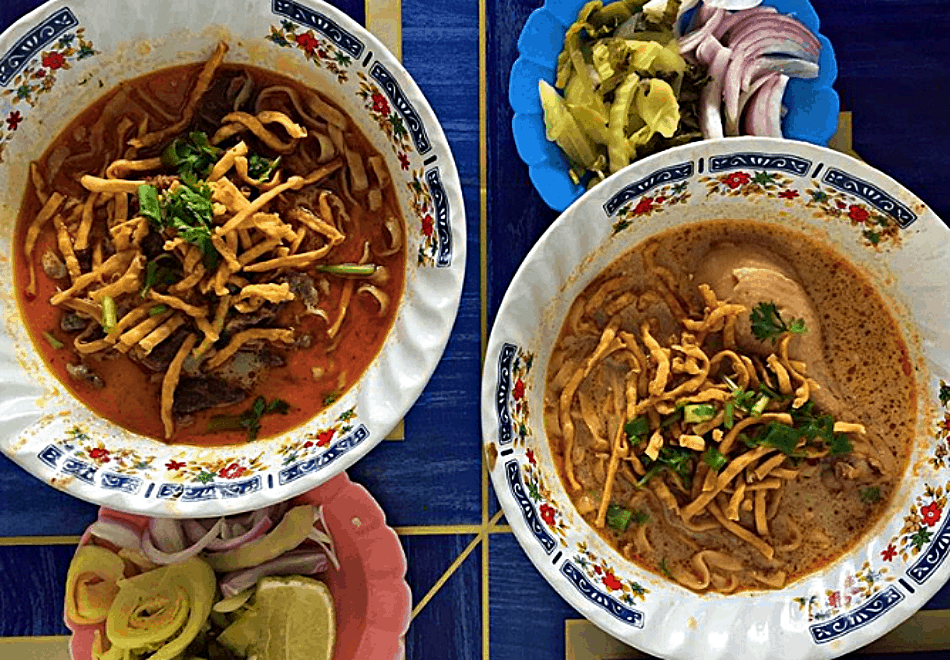
It is a rich and savory soup flavored with curry and coconut milk, served over egg noodles, and topped with crispy fried noodles. Khao Soi is normally served with a side of sliced shallots, chili oil, and lime wedges.
You can normally choose between chicken and beef, however; some new restaurants and vendors I have seen offer seafood and pork as protein options, too.
Khao Soi is one thing that Fiat said he misses the most about Chiang Mai. “It reminds me of home and my childhood.” His favorite Khao Soi spot is actually right in front of his grandparents’ house. The small hole-in-the-wall place has been there as long as he can remember.
It is funny how it has become very famous now because it was featured on Somebody Feed Phil on Netflix. See more info on this place below.
Recommended Spot for Khao Soi
Khao Soi Lung Prakit
You can’t imagine how many times Fiat keeps talking about this Khao Soi place. He would stop there for lunch every time he visits Chiang Mai.
“Lung Prakit” (Translates to “Uncle Prakit”) is a kind old man who was one of the very first food vendors at Kaad Korm market. Over 40 years, Lung Prakit has maintained the quality of his tender fall-off-the-bone chicken and beef. Now that it’s very popular, Lung Prakit still sells it for super cheap.
You can try other more popular Khao Soi restaurants like Khao Soi Nimman and Lam Duan, but Fiat and I guarantee you that this one won’t disappoint.
What to Order: Eng: Chicken Kao Soi | Th: ข้าวซอยไก่ (Khao Soi Gai)
Price Range: THB 40 – THB 60 per bowl/plate
Hours: Mon – Sun | 9:00 AM – 5:00 PM
Address: 53 Suriyawong 5 Rd, Tambon Hai Ya, Mueang Chiang Mai District, Chiang Mai 50100, Thailand
2. Sai Oua (Northern Sausage)
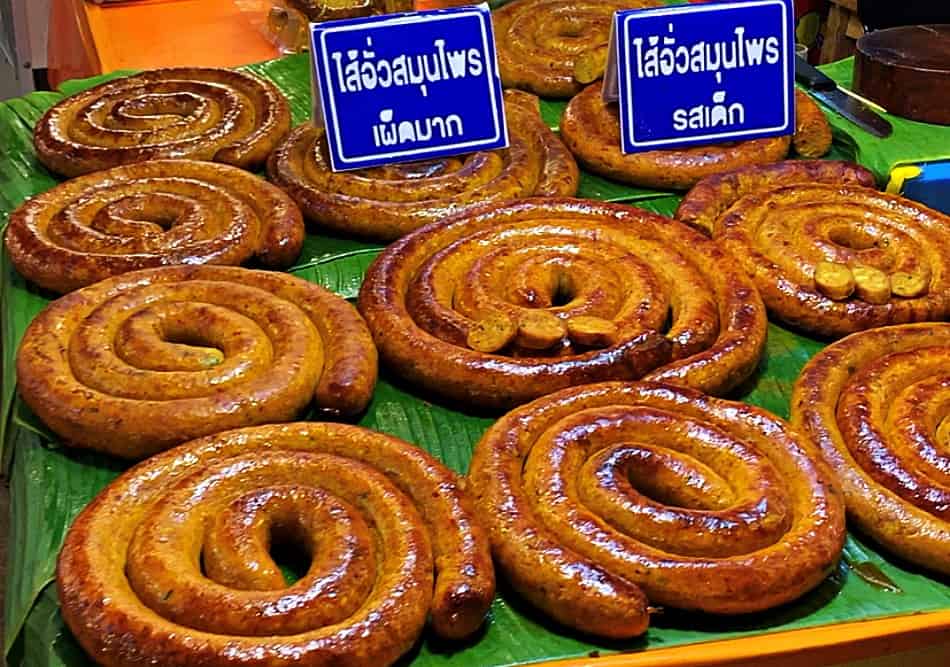
It’s very common to walk down a street in Chiang Mai and see a heap of smoke up in the air. You are probably walking into a Sai Oua vendor.
I’m pretty sure you have seen many versions of sausages since most nations and regions tend to have their own version of sausages. But, hear me out, this northern-style sausage Sai Oua is a whole new level!
Sai Oua is fragrant sausages made of ground pork and dried chilies, lemongrass, garlic, shallots, kaffir lime leaves, and galangal. One bite of Sai Oua is packed with mind-blowing flavors from a blend of Thai spices and herbs.
Tip #1: Sai Oua looks very similar to Issan-style sausages but it tastes so much different. The northern-style is richer in herbal aromas and much less sour.
They are normally cut into bite-size pieces for a quick grab-and-go breakfast. They are also perfect as an appetizer or an entree to go with sticky rice or other dishes on your table. Really, there is no specific way to eat these delicious sausages.
You can find them in most markets in Chiang Mai, usually coiled up. They are sold by grams and kilos, so just tell the vendor how much you want and they will cut it up for you.
Recommended Spot for Sai Oua
Sai Oua Dumrong
You can’t get any more authentic Sai Oua than Sai Oua Dumrong. Ask any Chiang Mai local, they will know this place.
This Sai Oua stall has been grilling their northern sausages for over 40 years in Warorot Market (Kad Laung), the biggest and most well-known market in Chiang Mai. I love the variety of food that they offer at this particular stall.
Besides the Sai Oua, Fiat recommends getting the fried pork strips (Moo Tod). Both of them are so good with warm sticky rice.
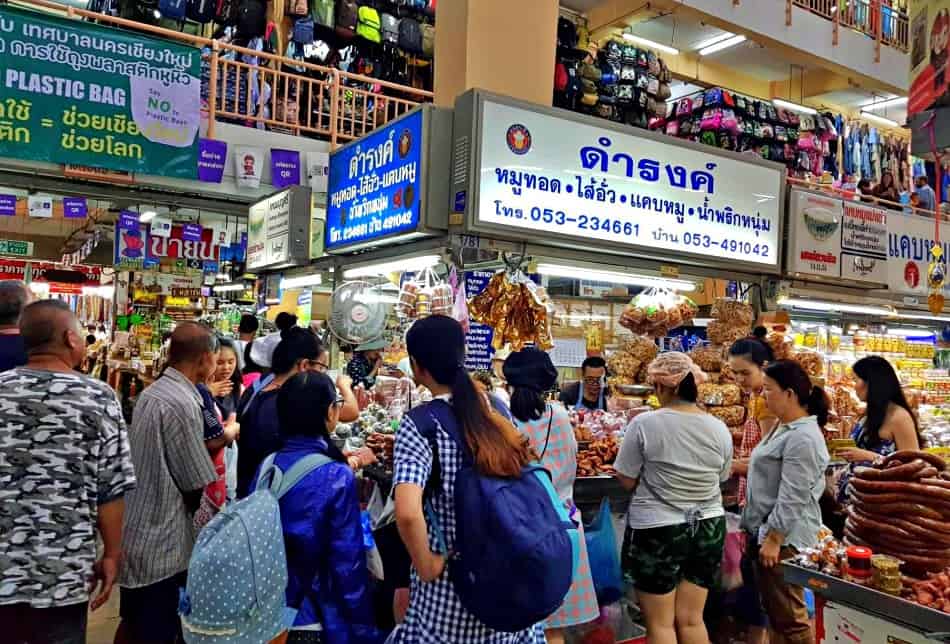
Right in the center of Warorot Market with normally the longest line, you will easily see it when you get there. I recommend getting there early to avoid the crowd.
Unlike Night Bazaar and Ta-Pae walking street, Warorot Market targets mostly Thais. So it is a great place for you to experience the local way of life while shopping for inexpensive local food, snacks, fresh produce, and clothing.
Tip #2: They can also pack the food in a box for a long domestic trip or you can request it to be cut in ready-to-eat pieces so you can go right ahead and enjoy your hot meal while shopping in this huge market.
What to Order: Eng: Sai Oua | Th: ไส้อั่ว
Price: THB 400 per kg (you can also buy 100 g for THB 40)
Hours: Mon – Sun | 8:00 AM – 4:00 PM
Address: Chang Moi Sub-district, Mueang Chiang Mai District, Chiang Mai 50300, Thailand
3. Kanom Jeen Nam Ngeow (Spicy Tomato Noodle Soup)
Another dish Fiat wouldn’t stop talking about, Kanom Jean Nam Ngeow, has a special place in his heart. It’s the fragrance and spicy texture that reminds him of home. Didn’t he say this about Khao Soi? Well, he contended, “put this right next to it!”
This dish is a noodle soup with pork rib broth, tomatoes, soybean paste, dried cubed pork blood alongside pork meat, all over vermicelli noodles. The main base of tomatoes gives it the red color and sour, refreshing taste.
And oh, did I say that it’s served with fried garlic, pickled cabbage, and bean sprouts? These sides definitely give you the freshness combo!
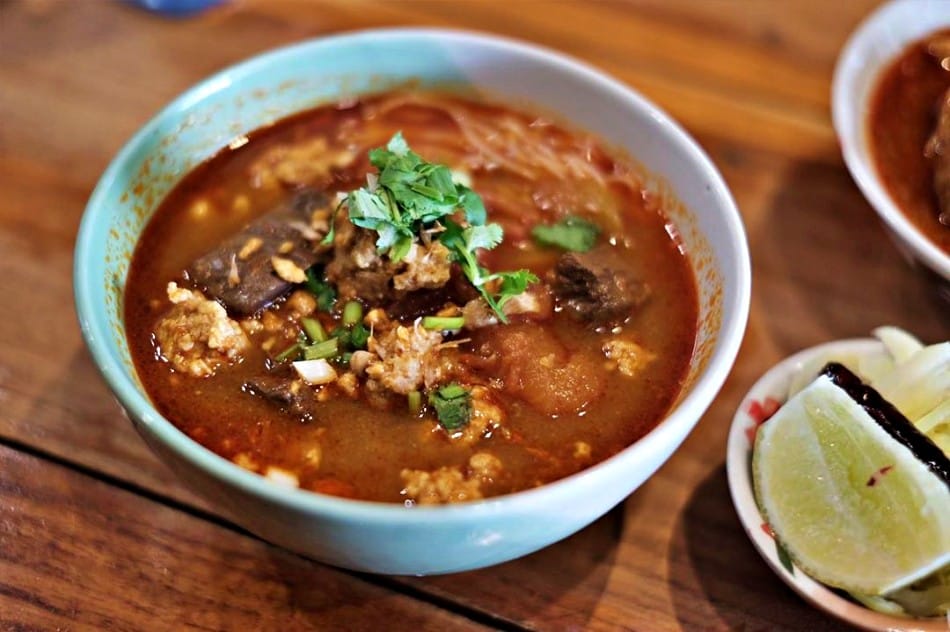
Like I mentioned earlier, Chiang Mai food is much influenced by Burmese cuisine. The dish originated from the Ngeow tribe (derogatory term for Tai Yai and Shan) of Burma and got brought into northern Thailand when the tribe fled to Thailand.
My Burmese friend told me that there is a similar dish called Shan Noodles that is common street food in Myanmar.
Interestingly enough, I have stumbled across something very similar to Kanom Jeen Nam Ngeow at a Laotian restaurant in California. It’s called Khao Soi. Weird right? But just in case you crave the dish after your trip, you know you can still find it.
Recommended Spot for Kanom Jeen Nam Ngeow
Kanom Jeen San Pa Khoi
Not just the Chiang Mai’s famous Kanom Jeen Nam Ngeow, they let you choose whatever kind of soup/curry you want to go over your noodles from green curry, Bangkok-style coconut milk curry, spicy red curry, to spicy beef curry, all for 20 Baht! Don’t like noodles? They got you covered, you can get it over rice for just 10 Baht extra.
This place will give you the nostalgia of being in a school cafeteria. You get in line, decide what to order from the menu, tell the vendor what you want (or point at it, no biggie), take the food, pay, grab utensils, and find yourself a table.
Oh, there’re also all-you-can-eat fresh vegetables for you to put on the noodles or on the side. And don’t forget to put away your stuff when you are done, remember, it’s like a cafeteria.
This is Fiat’s aunt’s favorite place to get noodles that would later become his favorite. His story is that the first experience with this place was 5 years ago when his aunt took him there.
Back then he thought his aunt made pretty good Nam Ngeow, so he went with no expectation. Plus, 20 Baht (75 cents) for a bowl of noodles sounded questionable. “Man, I was so wrong. It was the best Kanom Jeen Nam Ngeow I had ever had,” he said. I sure hope he didn’t tell his aunt that.
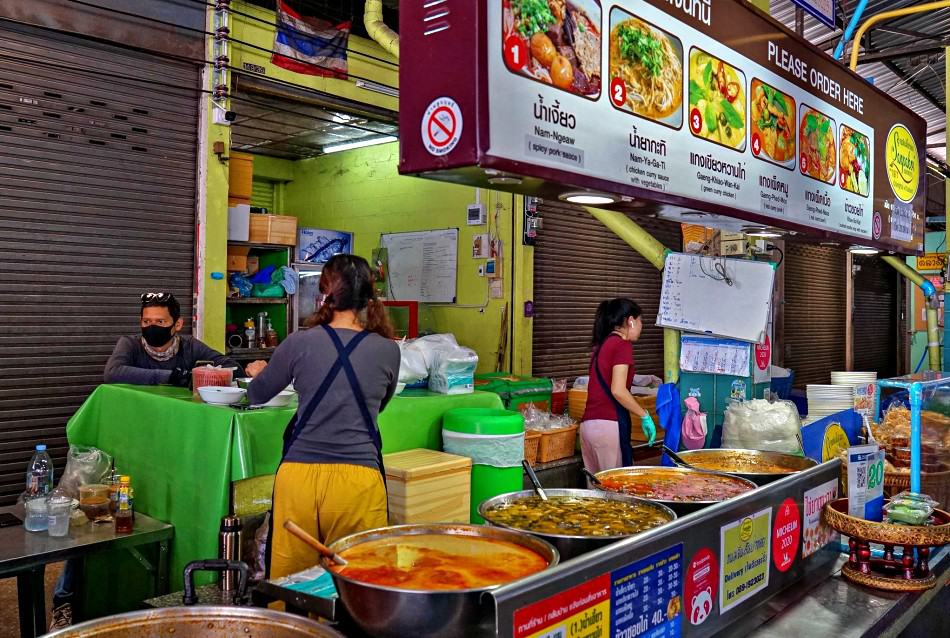
What to Order: Eng: Kanom Jeen Nam Ngeow | Th: ขนมจีนน้ำเงี้ยว
Price Range: THB 20 – THB 30 per bowl/plate
Hours: Mon – Sat | 11:00 AM – 9:00 PM
Address: ตลาดทองคำ Tasatoi Alley, วัดเกตุ Mueang Chiang Mai District, Chiang Mai 50000, Thailand
4. Gaeng Hang Lae (Northern Ginger Curry)
This is another dish that is very popular in Chiang Mai and it is hard to find anywhere else. I have seen it from many local market vendors and many Chiang Mai restaurants.
Gaeng Hang Lae can sometimes be referred to as “Burmese curry.” It is a curry dish that also has its roots in Myanmar, but it uses less oil than that of the Burmese.
Its masala-like fragrance comes from Myanmar’s neighboring country India. The influence of Indian cuisine definitely flew to northern Thailand.
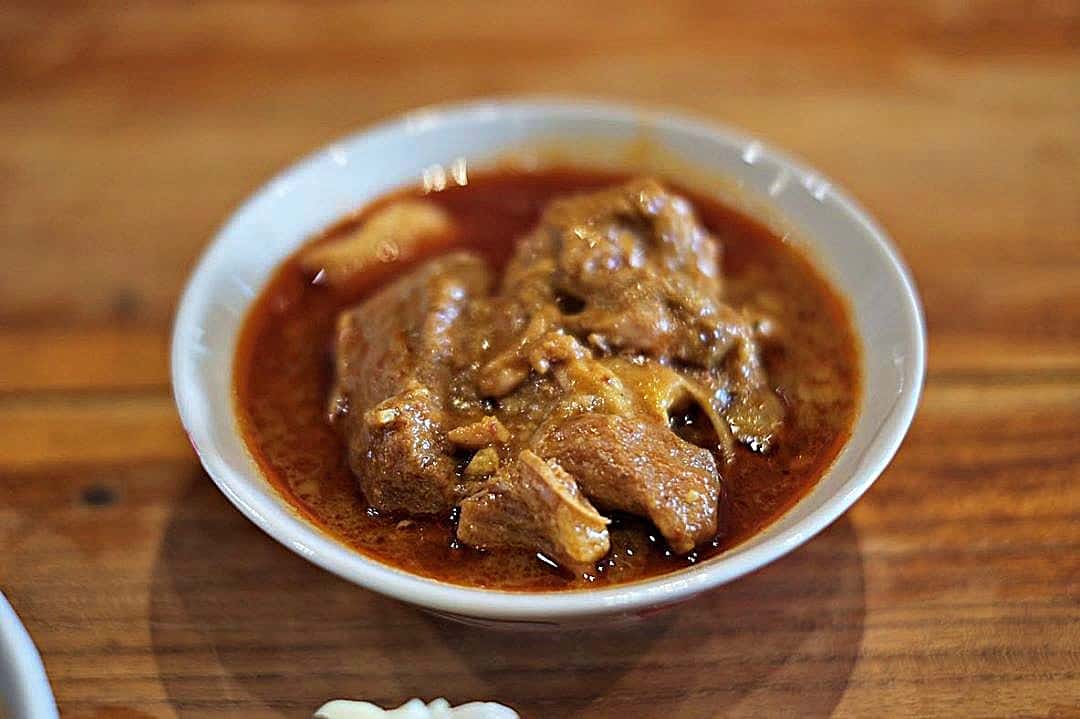
Gaeng Hang Lae also shares a lot of similarities with Massaman curry, which is a popular Thai curry served in many Thai restaurants in the U.S. But the key difference is that Gaeng Hang Lae, as well as other northern-style curries, don’t have coconut milk.
I love the rich flavor and fragrance of the curry. Not only does Hang Lae curry powder give it a unique smell, but ginger, galangal, pickled garlic, and tamarind all together explode exotic herbal aromas and rich flavors in just one bite.
The tender yet fatty pork belly is usually simmered for hours making it melt in your mouth. Some food stalls add in some pineapple chunks to beat the fattiness of pork belly, plus they add sour kicks to the curry.
Recommended Spot for Gaeng Hang Lae
Chiang Mai Vanusnun
Love Gaeng Hang Lae so much? You can take it home with you. Fiat discovered Vanusnun about 3 years ago when he went back to visit my family in Chiang Mai. They sell Gaeng Hang Lae in sealed pouches that last for months!
Fiat always goes there to grab packages of food to bring back with him before he leaves Thailand and he actually let me try it once. I first thought of the military’s MRE and hesitated to try it, but it was actually very good. It only needs to be heated in a microwave (or you can put the package in hot water), and you can experience the taste of Chiang Mai anywhere.
Vanusnun is one of the biggest souvenir shops in Chiang Mai. They use integrated food processing technology to securely pack the food to last longer and can be brought through airport security.
Tip: Just a friendly warning, put the food in checked luggage rather than a carry on bag. Also, avoid bringing anything with pork to the U.S., the airport security won’t like that.
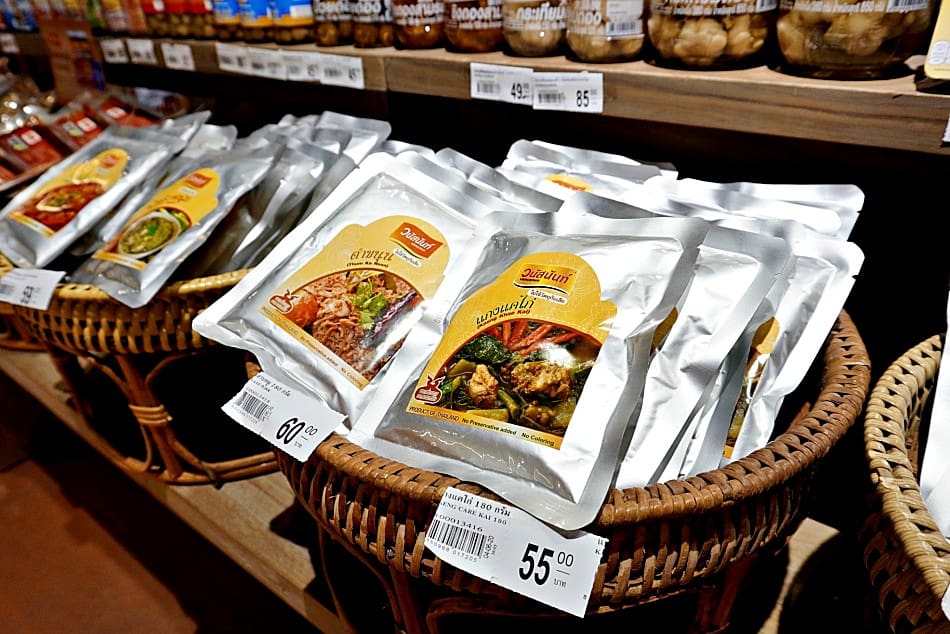
What to Buy: Eng: Gaeng Hang Lae | Th: แกงฮังเล
Price Range: THB 45 – THB 75 per 180 g pouch
Hours: Mon – Sun | 8:00 AM – 7:00 PM
Address: 398 Chiang Mai – Lampang road, Fhaham Chiang Mai, Thailand 50000
5. Nam Prik Ong/Nam Prik Nume (Green and Red Chili Dips)
No matter where you go in Thailand, you will find chili pastes. Thai people love spicy food even in the northern region where the food is a little milder. In Chiang Mai, Nam Prik Ong and Nam Prik Nume are served as vegetable and crispy pork rind dips. Let me explain what each of them is.
Nam Prik Ong
Similar to red meaty spaghetti sauce, Nam Prik Ong is a red chili paste made with tomato paste, ground pork, chopped cilantro, bird-eye chilies, garlic, and shallots. I really recommend this if you are not fond of spicy food. It is very mild, yet flavorful with the taste of fresh herbs and garlic.
Nam Prik Noom
This one is my favorite! It is a thick green chili paste made with roasted green chili peppers, garlic, and shallots. It can be pretty fiery that will leave your tongue burning, but you can’t stop eating it — if you know what I mean. The smokey and garlicky tastes make a good pairing with salted crispy pork rinds and steamed vegetables.
Nam Prik Ong and Nam Prik Noom are common souvenirs that people buy when they visit Chiang Mai. Fiat’s mom would buy a bunch of these for her friends whenever she went to Chiang Mai to visit our grandparents. This explains how good and rare they are.
Recommended Spot for Nam Prik Ong/Nam Prik Nume
Tong Tem Toh
Located in the middle of the most “chic” part of the city, Tong Tem Toh offers an extensive authentic Lanna menu. It’s Fiat’s go-to place for rare, hard-to-find traditional dishes.
While you can get the red and green chili dips basically at any market, right here they come in an appetizer platter with other tasty sides like Sai Oua, crispy pork rinds, hard-boiled eggs, and steamed vegetables.
Fiat also recommends other dishes like Katurai flower coconut curry soup with chicken and fried pork strips. He went there last winter and enjoyed everything on his table, but the platter was the highlight of his visit.
Tong Tem Toh is a very airy restaurant with a large sitting area. But even then, it’s always crowded. Get there early, before 11 AM for lunch and before 5 PM for dinner.
Here is a pro tip: Download this restaurant reservation app “QueQ” on your phone to secure your spot (download here: ios & android). Tong Tem Toh and many other restaurants in Chiang Mai are available on the app. I used it to book my restaurant reservations beforehand to skip long lines — very convenient!

What to Order: Eng: Northern Thai Style Hors D’oeuvre | Th: ออเดิร์ฟเมือง (Awe Durf Mueng)
Price Range: THB 200 – THB 250 per person with drinks
Hours: Mon – Sun | 7:00 AM – 9:00 PM
Address: 11 13 Nimmanahaeminda Road, Suthep, อำเภอเ มือง, Chiang Mai 50200, Thailand
6. Tum Kanoon (Young Jack-fruit Salad)
Tum Kanoon is a pan-fried young jack-fruit dish with curry paste, lemongrass, ginger, shallots, kaffir lime leaves, chilies, and fried garlic. It is a refreshing salad full of flavor with sweet, spicy, and nutty taste.
The young green jack-fruit is boiled til tender, then pounded with Thai spices. The name “Tum” as in Som Tum (papaya salad) refers to the process of pounding the jack-fruit in a pestle and mortar.
Unlike Som Tum, Tum Kanoon is a wok stir-fried dish with the shredded jack-fruit rather than pounding all the ingredients in the pestle and mortar.
In Fiat’s family, Tum Kanoon is normally served as a dip, just like the Nam Prik Ong and Nam Prik Nume chili dips. They eat it with crispy pork rinds, steamed vegetables, and warm sticky rice.
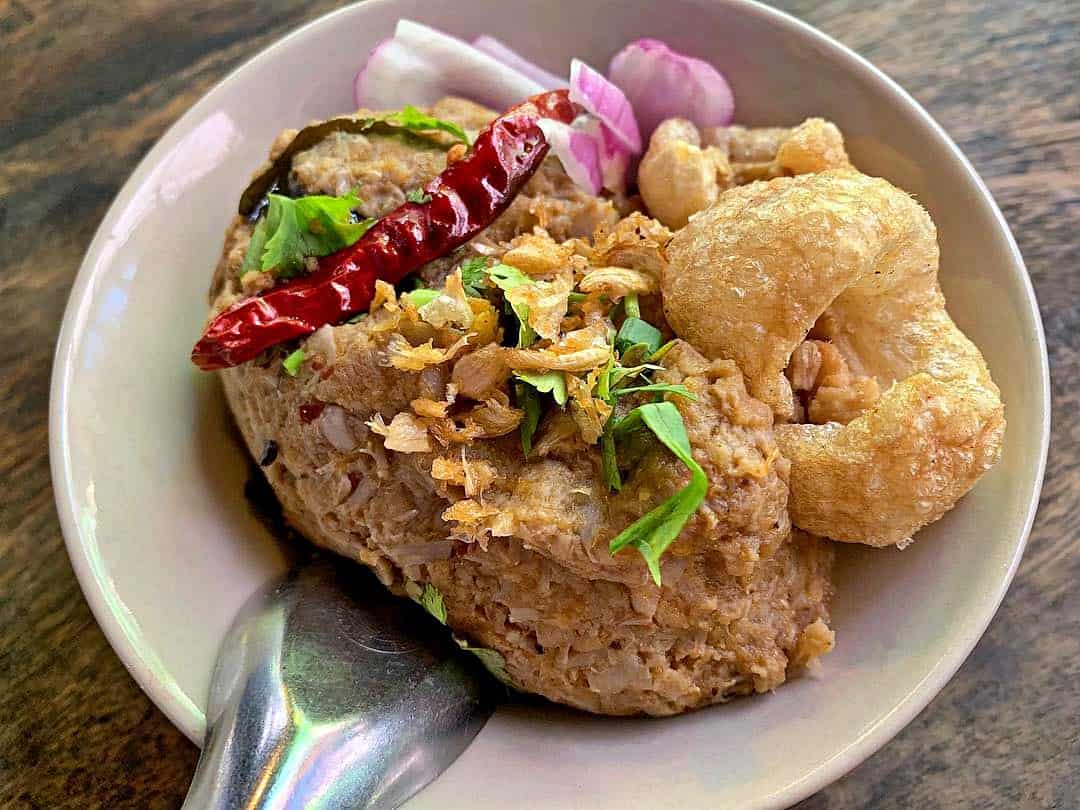
But what the heck is jack-fruit? When fresh, ripe, and uncooked, jack-fruit is sweet with the texture of pineapple and mango. The young unripe jack-fruit that is used in Tum Kanoon is somewhat bitter, but the taste changes to sweet when cooked. Next time you go to an Asian market, look for a big, bumpy, green fruit. That’s it, that’s the jack-fruit.
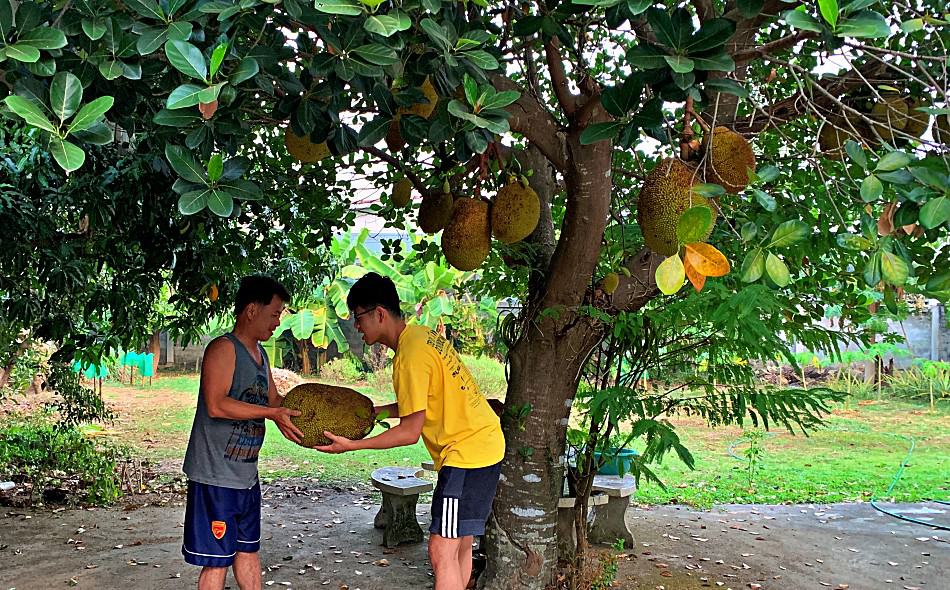
Jack-fruit (“Kanoon” in Thai) is a Thai lucky name that means support, security, and wealth. Hence, Tum Kanoon is normally served during Thai New Year’s and important ceremonies like weddings and housewarmings.
In the old days, it was common for a family to grow jack-fruit trees in the yard for good luck. So, Thai people would have jack-fruit to eat all year round. It can be eaten as is or put in salads, curries, and desserts.
Recommended Spot for Tum Kanoon
Huen Phen
This restaurant is another of Fiat’s family’s go-to places for easy dinner. It is a place where you can find delicious local food at reasonable prices.
Similar to Tong Tem Toh, Huen Phen offers a wide variety of traditional Chiang Mai dishes highlighted in this article including Khao Soi, Nam Prik Ong and Nam Prik Nume, Sai Oua, and Gaeng Hang Lae.
While most customers are locals at this restaurant, it is very foreigner-friendly. Huen Phen’s menu is written in Thai, Chinese, and English with pictures for each item so it is easy to order.
The wait can be long, but the service is super fast. You should get your food within 15 minutes at most after you have sat down and ordered.
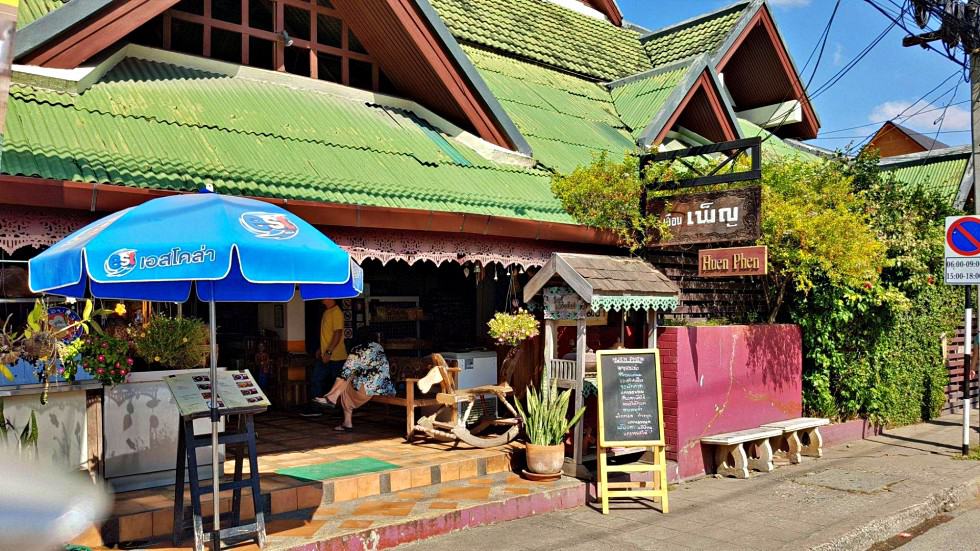
Huen Phen is located inside the Old City so it is easy to find. You can swing by this place for a quick lunch while you are exploring numerous cultural activities in Chiang Mai Old City.
They offer a dining room with air conditioning for you to escape Thailand’s heat. There is also a big breezy open-air area if you desire to have a full tropical dining experience.
What to Order: Eng: Tum Kanoon | Th: ตำขนุน/ตำบ่าหนุน (Tum Ka-noon/Tum Ba-noon)
Price Range: THB 80 – THB 120 per person with drinks
Hours: Mon – Sun | 8:30 PM – 4:00 PM and 5:00 PM – 10:00 PM
Address:112 พระสิงห์ เมือง Chiang Mai 50200, Thailand
7. Laab Koua (Pan-Fried Spicy Pork Salad)
Laab is a very popular dish in the Issan region. Most Thai restaurants in the U.S. serve the Issan version of laab. The Chiang Mai laab, my preferred version, is quite different and harder to find.
Both versions share some similarities, building from pork, chicken, or beef. The Chiang Mai laab, though, is spicier, darker, and more curry-ish than the eastern version.
Whereas the Issan laab includes fresh chilies, roasted rice, and lime juice, the Chiang Mai version uses dried chilies, laab curry powder, fried garlic, and kaffir lime leaves to reduce the savory smell.
The way it’s cooked is different, too. The Issan laab, the one you find in the U.S., is made salad-style where they will mix cooked meat in a bowl with other fresh ingredients. The Chiang Mai laab is cooked in a pan like a stir-fried dish.
Here’s where it gets interesting. Chiang Mai laab has intestine, pork blood cube, and pork skin. These organ meats may sound a little odd to some westerners. I’m not gonna lie, it took me some time to develop a taste for these organ meats. You will find that these unfamiliar ingredients are delicious and very nutritious once you overcome the fear of them.
Recommended Spot for Laab Koua
Laab Bunker
Talking about eating local, you can’t get any more local than this. Laab Bunker is so well-known among my Thai friends as a popular, cheap late-night spot after “wild” parties. They used to be open after midnight. Because of the global pandemic, they have changed the hours to 4 PM to 10 PM.
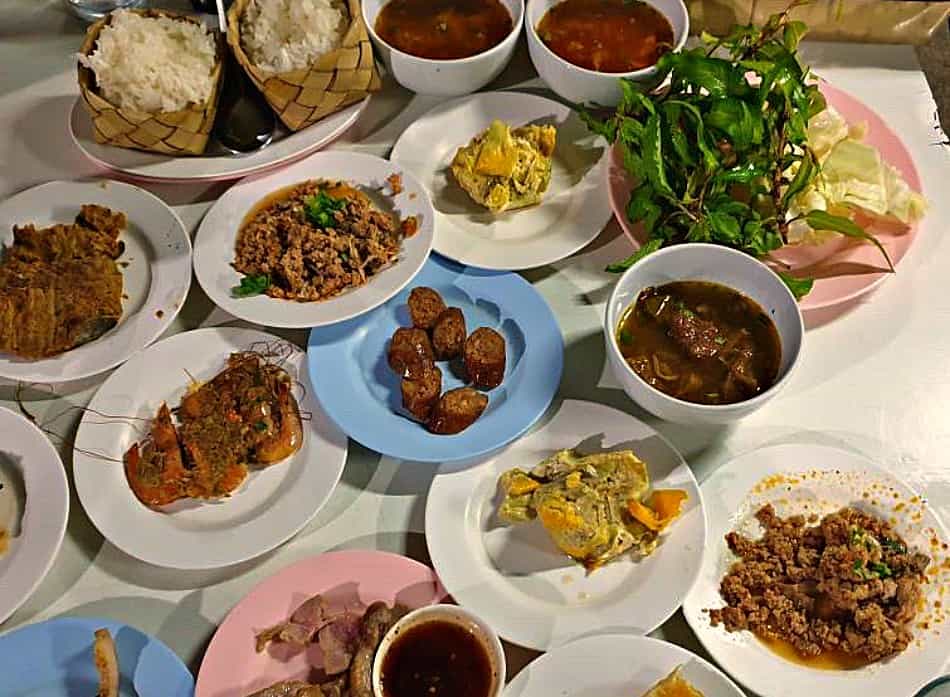
Cute price, cute portion, you gotta love it. They come in little plates so you can try many things in one sitting.
The must-order is Laab Koua. Sai Oua, Jin Som Mok Gai (grilled fermented pork with egg), Aoug-Or (grilled pork brain in banana leaf – trust me, it tastes so much better than it sounds), and grilled pork shoulder are delicious as well.
It is because this place hasn’t made it to mainstream tourism (just yet), so their menu is not written in English. I understand it may be confusing when you get there. So what you are going to need to do is find a table, then take a piece of the paper menu on the table and write how many of each dish you want (see the translation below).
Tip: Don’t forget to write your table number, then hand it to a server. Now, it’s only 10 Baht each (30 cents), they are going to be small. Order as many as you want and it still won’t break the bank.
What to Order: Eng: Laab Koua | Th: ลาบหมูสุก/ลาบคั่ว (Laab Moo Sook/Laab Koua)
Price Range: 50 – 60 per person with drinks
Hours: Tue – Sun | 4:00 PM – 10:00 PM
Address: 168 Chiang Mai-Lam Phun Rd, Tambon Wat Ket, Mueang Chiang Mai District, Chiang Mai 50000, Thailand
8. Chiang Mai Fried Chicken
One interesting thing to see while traveling through local and authentic foods is when the same dish is being approached in different ways in different countries.
Everybody loves fried chicken. As a matter of fact, the world loves it so much that unique recipes for fried chicken can be found in countries all around the world.
Chiang Mai is a place where you can find fried chicken in almost every local market. With warm sticky rice, it’s a popular grab-and-go meal on busy days.
Chicken in Chiang Mai is normally fried unlike in the Issan region where they grill their chicken. It is similar to southern fried chicken in the U.S., fried chicken in Chiang Mai is seasoned, breaded, and deep-fried until crunchy and crusty on the outside and juicy and on the inside.
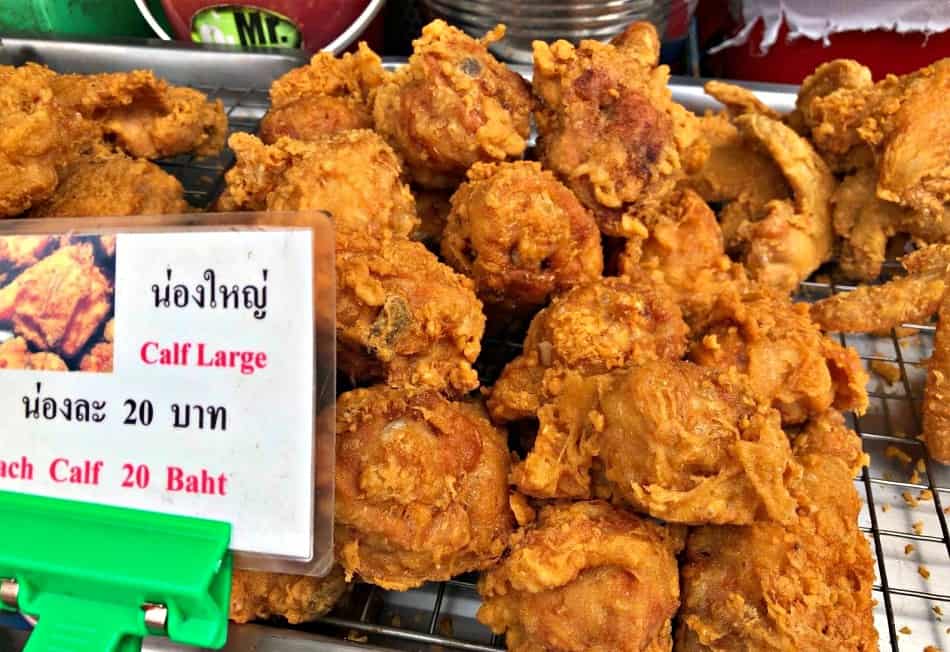
The fried chicken is marinated in garlic, lemongrass, thin soy sauce, and fish sauce. One bite of the chicken is packed with flavors and aromas. The skin is crunchy and the meat hiding beneath is tender and extremely flavorful as it is marinated at least overnight.
Recommended Spot for Chiang Mai Fried Chicken
Gai Tod Tiang Kuen (Midnight Fired Chicken)
I have heard that this is a place after late-night study sessions. My friend Fiat would shake his head saying it’s really for drunk college students trying to sober up before they go home. Anyway, he said that this spot is one of the few places he goes to when late-night hunger strikes.
Midnight Fried Chicken provides the standard Lanna food like fried chicken (of course), fired port belly, Sai Oua, Nam Prik Nume, and boiled duck eggs.
The gimmick of this place used to be that it wasn’t open till midnight, that’s why it’s called Midnight Fired Chicken. Now it’s open from 8 PM to 5 AM so early birds can enjoy it, too.
So, if you wake up in the middle of the night or you can’t get over jet-lag, head over to Midnight Fried Chicken to satisfy your midnight craving.
Oh, one more tip, there are no utensils here. You are going to have to eat it the northern Thai way with your fingers — it’s finger-licking good!
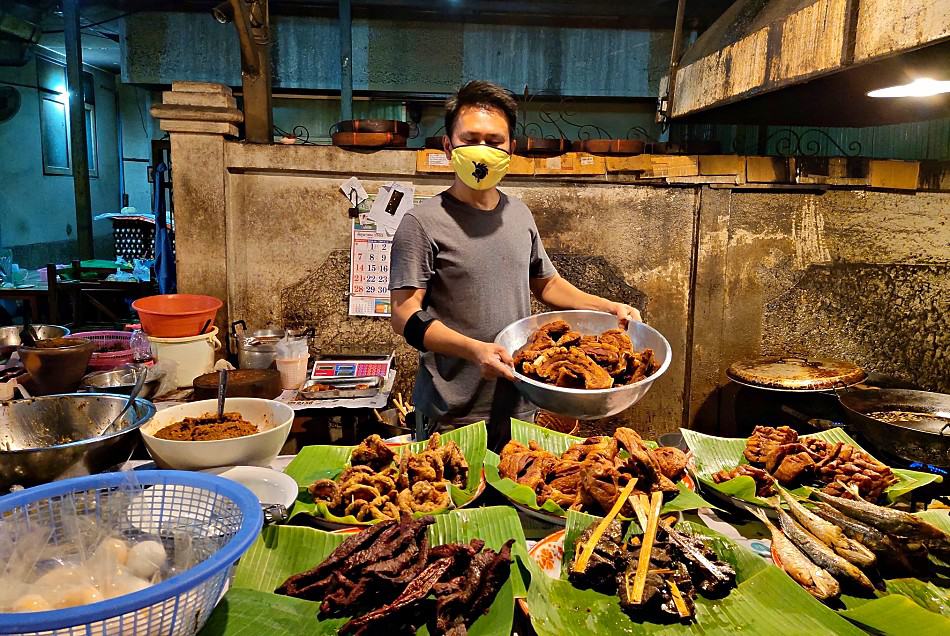
What to Order: Eng: Fried Chicken | Th: ไก่ทอด (Gai Tod)
Price Range: THB 80 – THB 100 per person
Hours: Mon – Sat | 8:00 PM – 5:00 AM
Address: 139 Kampangdin Rd, Tambon Phra Sing, เมือง Chiang Mai 50000, Thailand
9. Kanom Jok (Sticky Rice and Coconut Dessert)
Now let’s talk about dessert. Kanom Jok is a very traditional Chiang Mai dessert that is starting to become unknown for young people. It is a dessert that is prepared for Buddhist religious events and holidays, especially for Songkran Day. The pyramidal-shaped dessert resembles a pagoda in Buddhist temples where people bring food and desserts to feed the monks for good blessings.
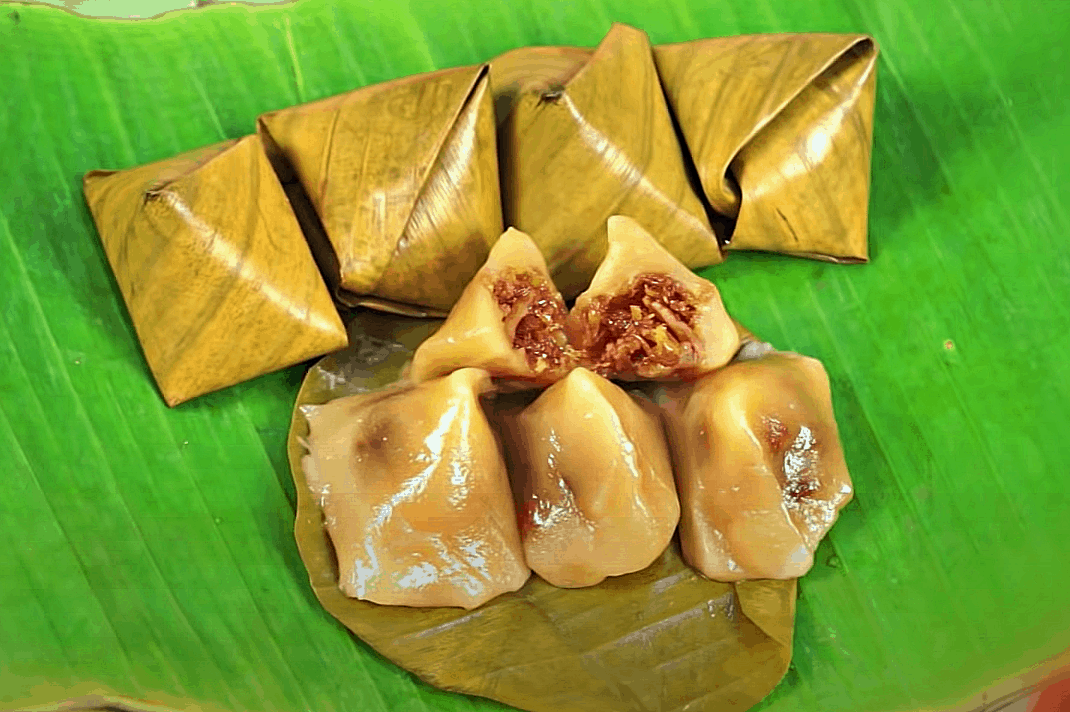
It is steamed sticky rice dough with coconut and sugarcane filling. The sugarcane juice gives the dessert a distinctly sweet flavor and aroma different from processed sugar.
Steamed inside banana leaf wrapping, Kanom Jok has a slightly minty and almost tea-like fragrance. A bonus to you, this local dessert is vegan-friendly.
The Chiang Mai version of Kanom Jok is made with the sweet coconut filling, but other versions like Bangkok’s Kanom Tian come with sweet bean paste and salted egg. You may find different filling options at one stall. Try them all to find your favorite.
Recommended Spot for Kanom Jok
Warorot Market (Kad Laung)
This is the same market I recommended you to get the Sai Oua sausage. But as I have said before, this is the biggest market in Chiang Mai with a huge variety of local food and snacks. You will definitely find the best Kanom Jok here.
My friend Fiat told me that there are so many dessert vendors at Warorot Market that he doesn’t have a particular favorite one. He just decides when he gets there by the volume of customers, the busier the better.
For me, the reason to go to Warorot market for Thai dessert is its variety and inexpensive prices. You can always walk around and see what interests you, try a little bit of everything from different vendors to see what you like, and you can go back for more if you remember the directions!
What to Order: Eng: Kanom Jok/Kanom Tian | Th: ขนมจ๊อก/ขนมเทียน
Price Range: THB 5 – THB 10 per piece
Hours: Tue – Sun | 5:00 AM – 10:00 PM
Address: Wichayanon Rd, Tambon Chang Moi, Mueang Chiang Mai District, Chiang Mai 50300, Thailand
Hopefully, the first 9 best Chiang Mai dishes above have made you all hungry by now.
I really, really recommend that you try all of these when you get a chance to visit Chiang Mai.
But let’s be real, it can be difficult to go around town to find all these, and it can be intimidating to order foreign food when you don’t know the language. So, here is a little surprise for the last one.
10. Khan Toke
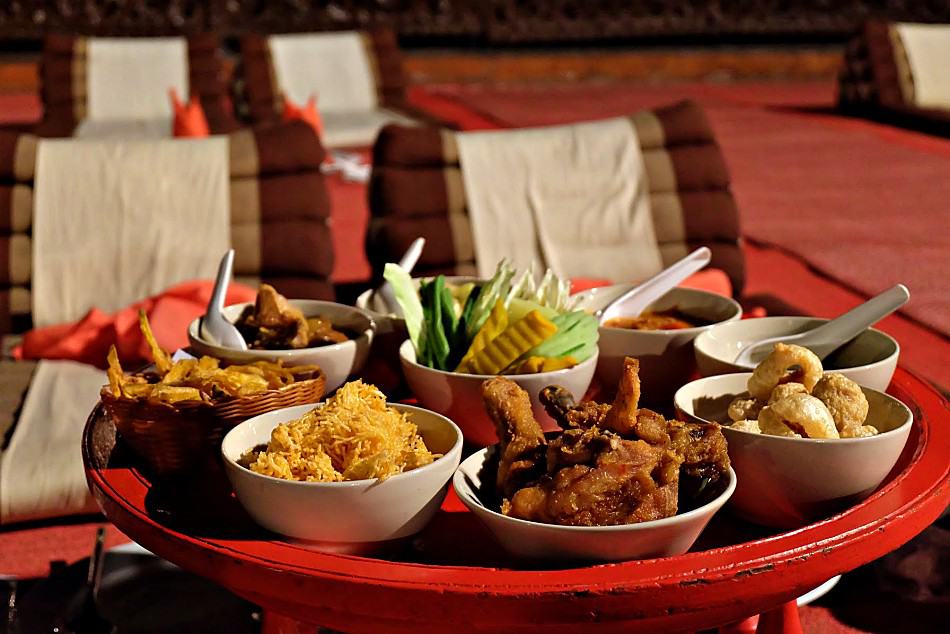
This Chiang Mai food guide would not be complete without the Khan Toke. It is a full Lanna dining experience featuring delicious traditional Lanna food and a dance show in a traditional northern setting.
Most dishes I mentioned above are included in the Khan Toke!
The term “Khan Toke” refers to a round pedestal tray that the Thais, especially in the North, use as a dining table. My friend Fiat actually grew up using a table like this to eat his breakfast, lunch, and dinner.
Similar to the Japanese short-legged table Chabudai, the Khan Toke table is a short little table that is designed for diners to sit on the floor while eating off of the table.
If you have been eating on a chair all your life, this will definitely give you a whole new experience. You might not want to sit on a regular dining chair again.
Recommended Spot for Khan Toke
Khan-toke Dinner at Old Chiang Mai Cultural Center
Khan-toke Dinner at Old Chiang Mai Cultural Center is where you can enjoy all-you-can-eat Thai Lanna food and traditional dancing shows.
I had a great time practicing the Chiang Mai way of dining sitting on bamboo mats on the floor again now that the old tradition is fading away.
The food includes Gaeng Hang Lae (Burmese-style curry), Nam Prik Ong chili dip, Nam Prik Nume chili dip, crispy pork rinds, steamed vegetables, fried chicken, sticky rice and more.
Tip: You can also request a vegetarian option at no extra cost.
Sitting on the floor may not be the most comfortable thing in the world, I won’t judge you on this. At the Old Chiang Mai Cultural Center, you can request to sit on a dining table.
The two most popular Khan Toke dinners in Chiang Mai are Khum Khantoke and Khan-toke Dinner at Old Chiang Mai Cultural Center. I have been to Khum Khantoke, but Fiat has taken his family to both places. He and his family agreed that Khan-toke Dinner at Old Chiang Mai Cultural Center is superior.
He said that he food at both places is similar, but he has had better customer service at the Old Chiang Mai Cultural Center, plus there are more dances at this place.
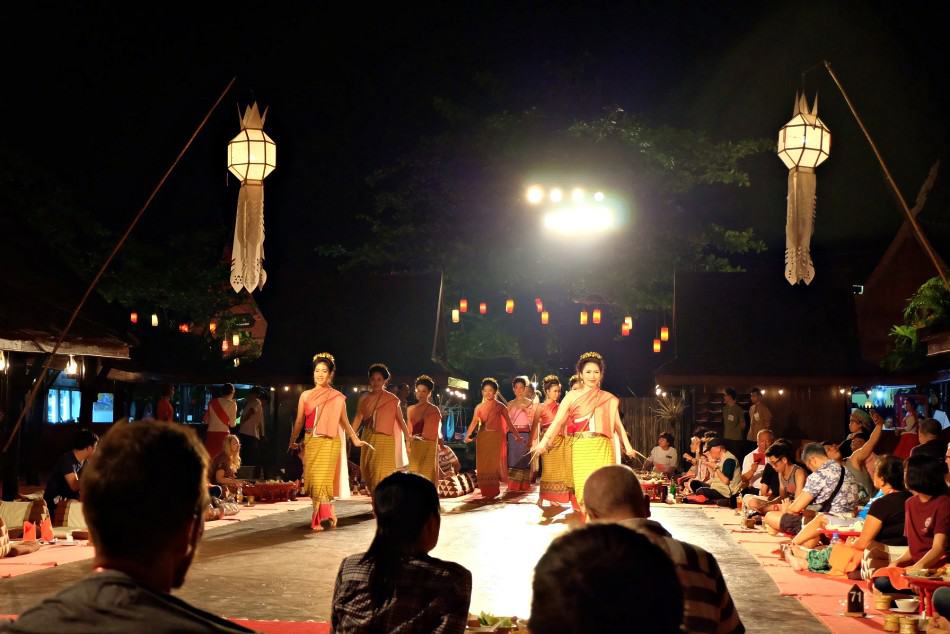
Fiat books his tickets from this website for 490 Baht per person (the cheapest he has found). This price includes coffee and tea, but you can buy water, soft drinks, and beer on the spot. Make sure to choose a pick-up option if you want to be picked up.
What to Order: Eng: Khan Toke dinner | Th: ชุดขันโตก (Shoot Khan Toke)
Price: THB 490 per person through this website (excluding water, soda, and transportation)
Hours: Mon – Sun | 8:00 PM – 10:00 PM
Address: 185/3 Wua Lai Rd, Tambon Haiya, Mueang Chiang Mai District, Chiang Mai 50100, Thailand
Conclusion
Chiang Mai is chuck full of great authentic food and thanks to my friend Fiat, we all know where to get the best of it. Sometimes you just have to ask a local. They usually know best.
Check out my article on how to spend “Three Memorable Days in Chiang Mai” here.
Happy times eating Lanna food in Chiang Mai, Thailand!
